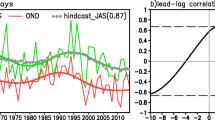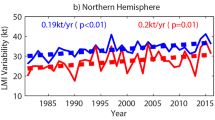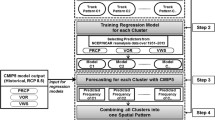Abstract
Tropical cyclones (TCs) are major meteorological hazards for coastal communities around the world. Among the most active TC development basins are the North Atlantic (NATL) and the eastern North Pacific (ENP), both of which bring impacts to the USA and other countries of North America. This research assesses the climatology of occurrence dates of nth (e.g., 1st and 2nd,) TCs and hurricanes in both basins, as well as occurrence dates of accumulated cyclone energy thresholds. We use statistical methods to develop a base climatology of occurrence dates and assess their trends over time, as well as correlate early season nth TC and hurricane occurrence dates with overall seasonal activity. We find that the climatologies of NATL and ENP occurrence dates exhibit similarities but unique differences that relate to the TC climatologies of their basins. In addition, we find that NATL nth TC occurrence dates generally have been trending earlier with time, while no trends were identified for the ENP or for hurricanes in either basin. Lastly, we find that early season TCs possess the ability to postulate overall seasonal activity in both basins, the strongest correlations in each basin coming from the 3rd and 4th TCs in the NATL and the 5th and 6th TCs in the ENP. Results of this study have utility in improving seasonal TC forecasts for the NATL and ENP made by 1 September and 1 August, respectively, as well as providing a baseline for modeling studies.












Similar content being viewed by others
Data Availability
Not applicable.
References
Bell GD, Halpert MS, Schnell RC, Higgins RW, Lawrimore J, Kousky VE et al (2000) Climate assessment for 1999. Bulletin of the American Meteorological Society 81(6):S1–S50
Beven JL (2017) The 2016 Atlantic hurricane season: Matthew leads an above-average season. Weatherwise 70(3):28–35
Blake, E. S., Gibney, E. J., Brown D. P., Mainelli M., Franklin, J. L., Kimberlain, T. B., & Hammer, G. R. (2009): Tropical Cyclones of the Eastern North Pacific basin, 1949–2006. (Vol. 6, No. 5). US Department of Commerce, National Oceanic and Atmospheric Administration, National Weather Service, National Environmental Satellite, Data, and Information Service.
Cangialosi, J.P. (2020a) Tropical Cyclone Report Tropical Depression One-E (EP012020). Miami, FL. Available at: National Hurricane Center. https://www.nhc.noaa.gov/data/tcr/EP012020_One-E.pdf.
Cangialosi, J.P. (2020b) Tropical Cyclone Report Tropical Storm Bertha (AL022020). Miami, FL. Available at: National Hurricane Center. https://www.nhc.noaa.gov/data/tcr/AL022020_Bertha.pdf.
Chenoweth M, Landsea C (2004) The San Diego Hurricane of 2 October 1858. Bulletin of the American Meteorological Society 85(11):1689–1698
Colorado State University, Individual Basin Tropical Cyclone Activity for 2020. Available at https://tropical.colostate.edu/forecasting.html. Accessed 18 January 2021.
Dvorak VF (1975) Tropical cyclone intensity analysis and forecasting from satellite imagery. Monthly Weather Review 103(5):420–430
Ellis KN, Sylvester LM, Trepanier JC (2015) Spatiotemporal patterns of extreme hurricanes impacting US coastal cities. Natural Hazards 75(3):2733–2749
Ellis KN, Trepanier JC, Jagger TH (2016) Using synthetic tropical cyclones to characterize extreme hurricanes affecting Charleston, South Carolina. Journal of Applied Meteorology and Climatology 55(4):883–892
Gray WM (1968) Global view of the origin of tropical disturbances and storms. Monthly Weather Review 96(10):669–700
Gray WM (1984) Atlantic seasonal hurricane frequency. Part I: El Niño and 30 mb quasi-biennial oscillation influences. Monthly Weather Review 112(9):1649–1668
Hagen A., Morgerman J., Trabaldo E.S, & González J.A. 2016. Hurricane reanalysis: Great Mexico Hurricane of 1959. Available at http://icyclone.com/upload/now/feb_2016/Reanalysis_of_Great_ Mexico_Hurricane_1959_FINAL.pdf.
Hartwig F, Dearing BE (1979) Exploratory Data Analysis. Sage, Beverly Hills
Kanji GK (2006) 100 Statistical Tests, 3rd edn. Sage, London
Karloski JM, Evans C (2016) Seasonal influences upon and long-term trends in the length of the Atlantic hurricane season. Journal of Climate 29(1):273–292
Keim BD, Robbins KD (2006) Occurrence dates of North Atlantic tropical storms and hurricanes: 2005 in perspective. Geophysical Research Letters 33(21)
Keim BD, Muller RA, Stone GW (2007) Spatiotemporal patterns and return periods of tropical storm and hurricane strikes from Texas to Maine. Journal of Climate 20(14):3498–3509
Khouakhi A, Pattison I, López-de la Cruz J, Martinez-Diaz T, Mendoza-Cano O, Martínez M (2019) Tropical cyclone—Induced heavy rainfall and flow in Colima, western Mexico. International Journal of Climatology 40(6):3222–3231
Kim D, Kim HS, Park DSR, Park MS (2017) Variation of the tropical cyclone season start in the Western North Pacific. Journal of Climate 30(9):3297–3302
Klotzbach PJ, Gray WM (2003) Forecasting September Atlantic basin tropical cyclone activity. Weather and Forecasting 18(6):1109–1128
Klotzbach PJ, Gray WM (2008) Multidecadal variability in north Atlantic tropical cyclone activity. Journal of Climate 21(15):3929–3935
Klotzbach PJ, Landsea CW (2015) Extremely intense hurricanes: revisiting Webster et al. (2005) after 10 years. Journal of Climate 28(19):7621–7629
Klotzbach PJ, Schreck CJ III, Collins JM, Bell MM, Blake ES, Roache D (2018) The extremely active 2017 North Atlantic hurricane season. Monthly Weather Review 146(10):3425–3443
Klotzbach PJ et al (2019) Seasonal tropical cyclone forecasting. Tropical Cyclone Research and Review 8(3):134–139
Kossin JP (2008) Is the North Atlantic hurricane season getting longer? Geophysical Research Letters 35(23):L23705
Landsea CW, Franklin JL (2013) Atlantic hurricane database uncertainty and presentation of a new database format. Monthly Weather Review 141(10):3576–3592
Landsea CW et al (2014) A reanalysis of the 1931–43 Atlantic hurricane database. Journal of Climate 27(16):6093–6118
Larson J, Zhou Y, Higgins RW (2005) Characteristics of landfalling tropical cyclones in the United States and Mexico: climatology and interannual variability. Journal of Climate 18(8):1247–1262
Latto AS (2020a) The 2019 Eastern North Pacific Hurricane Season: An Average Year Headlined by Lorena and Narda. Weatherwise 73(3):40–46
Latto, A.S. (2020b) Tropical Cyclone Report Tropical Storm Arthur (AL012020). Miami, FL. Available at: National Hurricane Center. https://www.nhc.noaa.gov/data/tcr/AL012020_Arthur.pdf.
Lupo AR, Latham TK, Magill TH, Clark JV, Melick CJ, Market PS (2006) The interannual variability of hurricane activity in the Atlantic and East Pacific Regions. National Weather Digest 32(2):1–15
McAdie, C., Landsea, C., Neumann, C. J., David, J. E., & Blake, E. S. (2009). Tropical Cyclones of the North Atlantic Ocean, 1851-2006: With 2007 and 2008 Track Maps Included (Vol. 6, No. 2). US Department of Commerce, National Oceanic and Atmospheric Administration, National Weather Service, National Environmental Satellite, Data, and Information Service.
Molinari J, Vollaro D, Skubis S, Dickinson M (2000) Origins and mechanisms of eastern Pacific tropical cyclogenesis: a case study. Monthly Weather Review 128(1):125–139
Ritchie EA, Wood KM, Gutzler DS, White SR (2011) The influence of eastern Pacific tropical cyclone remnants on the southwestern United States. Monthly Weather Review 139(1):192–210
Sheskin DK (2004) Handbook of Parametric and Non-Parametric Statistical Procedures, 3rd edn. Chapman and Hall, Boca Raton
Smith W. (1986). NOAA Technical Memorandum NWS WR-197, The effects of Eastern North Pacific tropical cyclones on the southwestern United States. 229 pp.
Towry S (1975) Eastern North Pacific Tropical Cyclones, 1974. Part 2. Monthly Weather Review 103(6):550–559
Wang C, Lee SK (2009) Co-variability of tropical cyclones in the North Atlantic and the eastern North Pacific. Geophysical Research Letters 36(24)
Wood KM, Ritchie EA (2013) An updated climatology of tropical cyclone impacts on the southwestern United States. Monthly Weather Review 141(12):4322–4336
Wood, K.M., Klotzbach, P.J., Collins, J.M,. & Schreck, C. J. (2019). The record setting 2019 eastern North Pacific hurricane season. Geophysical Research Letters, 46(16), 10072, 10081.
Yan Y, Qi Y, Zhou W (2012) Variability of tropical cyclone occurrence date in the South China Sea and its relationship with SST warming. Dynamics of Atmospheres and Oceans 55:45–59
Acknowledgements
The authors acknowledge Dr. Alex Haberlie for providing the Python code used to clean the HURDAT dataset.
Code availability
Not applicable.
Author information
Authors and Affiliations
Contributions
N.S.G. and K.N.E. conceptualized the study; N.S.G and K.N.E. performed the analysis; N.S.G. and K.N.E. analyzed the data; N.S.G. and K.N.E. wrote the paper.
Corresponding author
Ethics declarations
Conflicts of interest
The authors declare no competing interests.
Consent for publication
Both authors consent to participate and publish this research.
Additional information
Publisher’s note
Springer Nature remains neutral with regard to jurisdictional claims in published maps and institutional affiliations.
Appendix
Appendix
Rights and permissions
About this article
Cite this article
Grondin, N.S., Ellis, K.N. Tropical cyclone occurrence dates in the North Atlantic and eastern North Pacific basins: climatology, trends, and correlations with overall seasonal activity. Theor Appl Climatol 146, 311–329 (2021). https://doi.org/10.1007/s00704-021-03734-6
Received:
Accepted:
Published:
Issue Date:
DOI: https://doi.org/10.1007/s00704-021-03734-6




